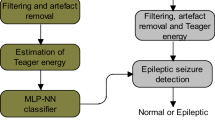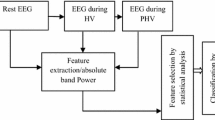Abstract
This paper presents an effective application of backpropagation artificial neural network (ANN) in differentiating electroencephalogram (EEG) power spectra of syncopic and normal subjects. Digitized 8-channel EEG data were recorded with standard electrodes placement and amplifier settings from five confirmed syncopic and five normal subjects. The preprocessed EEG signals were fragmented in two-second artifact free epochs for calculation and analysis of changes due to syncope. The results revealed significant increase in percentage δ and α (p<0.5 or better) with significant reduction in percentage θ activity (p<0.05). The backpropagation ANN used for classification contains 60 nodes in input layer, weighted from power spectrum data from 0 to 30 Hz, 18 nodes in hidden layer and an output node. The ANN was found effective in differentiating the EEG power spectra from syncopic EEG power spectra and the normal EEG power spectra with an accuracy of 88.87% (85.75% for syncopic and 92% for normal).
Similar content being viewed by others
References
Lamarre-Cliché, M., and Cusson, J., The fainting patient: value of the head-upright tilt table test in adult patients with orthostatic intolerancem. Can. Med. Assoc. J. 164:372–376, 2001.
Udani, V., Bavdekar, M., and Karia, S., Head up tilt test in the diagnosis of neurocardiogenic syncope in childhood and adolescence. Neurol. India 52:185–187, 2004.
Yadav, P., Sethi, A., Agarwal, A. K., and Jain, A., Syncope. J. Indian Acad. Clin. Med. 4:286–291, 2003.
Sheldon, R., Sexton, E., and Koshman, M. L. R., Usefulness of clinical factors in predicting outcomes of passive tilt test in patients with syncope. Am. J. Cardiol. 85:360–364, 2000.
Maurice, V., and Ropper, A. H., Principles of Neurology, 7th edn., McGraw Hill, USA, 2001.
Sherman, D. L., Brambrink, A. M., Ichord, R. N., Dasika, V., Koehler, R. C., Hanley, D. F., Koehler, R. C., Traystman, R. J., and Thakor, N. V., The EEG during early recovery from hypoxic-ischemic injury in immature piglets: the role of normalized separation and bursting. Clin. Electroencephalogr. 30:175–183, 1999.
Bezerianos, A., Tong, S., and Thakor, N. V., Tsallis entropy estimation of EEG rhythm following ischemia. Ann. Biomed. Eng. 31:221–232, 2003.
Barlow, M., and Leitch, J., How to treat syncope. Aust. Doct. 33–40, 2004.
Goel, V., Brambrink, A. M., Baykal, A., Koehler, R. C., Hanle, D. F., and Thakor, N. V., Dominant frequency analysis of EEG reveals brain's response during injury and recovery. IEEE Trans. Biomed. Eng. 43:1083–1092, 1996.
Williams, G. W., Luders, H. O., Brickner, A., Goormastic, M., and Klass, D. W., Interobserver variability in EEG interpretation. Neurology 35:1714–1719, 1985.
Sinha, R. K., Artificial neural network detects changes in electro-encephalogram power spectrum of different sleep-wake states in an animal model of heat stress. Med. Biol. Eng. Comput. 41:595–600, 2003.
Dubois, M., Sato, S., Lees, D. E., Bull, J. M., Smith, R., White, B. G., Moore, H., and Macnamara T. E., Electroencephalographic changes during whole body hyperthermia in humans. Electroencephalogr. Clin. Neurophysiol. 50:486–495, 1980.
Sinha, R. K., Electro-encephalogram disturbances in different sleep-wake states following exposure to high environmental heat. Medical and Biological Eng. Comput. 42:282–287, 2004.
Jervis, B., Coelho, M., and Morgan, G. W., Spectral analysis of EEG responses. Med. Biol. Eng. Comput. 27:230–238, 1989.
Rao, V., and Rao, H., C++ Neural Networks and Fuzzy Logic, 1st edn., BPB Publications, New Delhi, 1996.
Zurada, J. M., Introduction to Artificial Neural Network Systems, West Publishing Company, St. Paul, MN, 1997.
Hassoun, H. M., Fundamentals of Artificial Neural Networks, Printice-Hall of India Private Limited, New Delhi, 1998.
Rakotomamonjy, A., Migeon, B., and Marche, P., Automated neural network detection of wavelet preprocessed electrocardiogram late potentials. Med. Biol. Eng. Comput. 36:346–350, 1998.
Muthuswamy, J., Kimura, T., Ding, M. C., Geocadin, R., Hanley, D. F., and Thakor, N. V., Vulnerability of the thalamic somatosensory pathway after prolonged global hypoxic-ischemic injury. Neuresuscitationience 115:917–929, 2002.
Al-Nashash, H. A. M., A dynamic Fourier series for the compression of ECG using FFT and adaptive coefficient estimate. Med. Eng. Phys. 17:197–203, 1995.
Sarbadhikari, S. N., Dey, S., and Ray, A. K., Chronic exercise alters EEG power spectra in an animal model of depression. Indian J. Physiol. Pharmacol. 40:47–57, 1996.
Kulkarni, P. K., Kumar, V., and Verma, H. K., Diagnostic acceptability of FFT-based ECG data compression. J. Med. Eng. Technol. 21:185–189, 1997.
Sarbadhikari, S. N., A Neural network confirms that physical exercise reverses EEG changes in depressed rats. Med. Eng. Phys. 17:579–582, 1995.
Kosinski, D. J., and Grubb, B. P., Neurally mediated syncope with an update on indications and usefulness of head-upright tilt table testing and pharmacologic therapy. Curr. Opin. Cardiol. 9:53–64, 1994.
Edner, A., Katz-Salamon, M., Lagercrantz, H., and Milerad, J., Heart rate response profiles during head upright tilt test in infants with apparent life threatening events. Arch. Dis. Child. 76:27–30, 1997.
Davis, T. L., and Freemon, F. R., Electroencephalography should not be routine in the evaluation of syncope in adult. Arch. Intern. Med. 150:2027–2029, 1990.
Linzer, M., Yang, E. H., Estes, N. A. III, Wang, P., Vorperian, V. R., and Kapoor, W. N., Diagnosing syncope. Value of history, physical examination and electrocardiography, clinical efficacy, assessment projection of the American college of physicians. Ann. Intern. Med. 126:988–996, 1997.
Driscoll, D. J., Jacobsen, S. J., Porter, C. J., and Wollan, P. C., syncope in children and adolescents. J. Am. Coll. Cardiol. 29:1039–1045, 1997.
Gomes, M. M., Kropf, L. A., Breeck, E. S., and Figueira, I. L., Interferences from a community study about non-epileptic events. Arq. de Neuro-Psiquiatr. 60:712–716, 2002.
Rowland, L. P., Merritts Neurology, 10th edn., Lippincott Williams & Wilkins, Philadelphia, 2000.
Nejad, V. S., Ashtari, F., and Khorvash, F., A study of the relationship between syncope attacks and diminished carotid and vertebral artery flow using Doppler ultrasonography of cervical vessels. J. Res. Med. Sci. 10:97–100, 2005.
Author information
Authors and Affiliations
Corresponding author
Additional information
Certificate of Originality—This is to certify that the article submitted for publication in ‘Journal of Medical Systems’ has not been publ-ished, nor is being considered for publication, elsewhere. (Rakesh Kumar Sinha)
Rights and permissions
About this article
Cite this article
Sinha, R.K., Aggarwal, Y. & Das, B.N. Backpropagation Artificial Neural Network Detects Changes in Electro-Encephalogram Power Spectra of Syncopic Patients. J Med Syst 31, 63–68 (2007). https://doi.org/10.1007/s10916-006-9043-y
Received:
Accepted:
Published:
Issue Date:
DOI: https://doi.org/10.1007/s10916-006-9043-y




